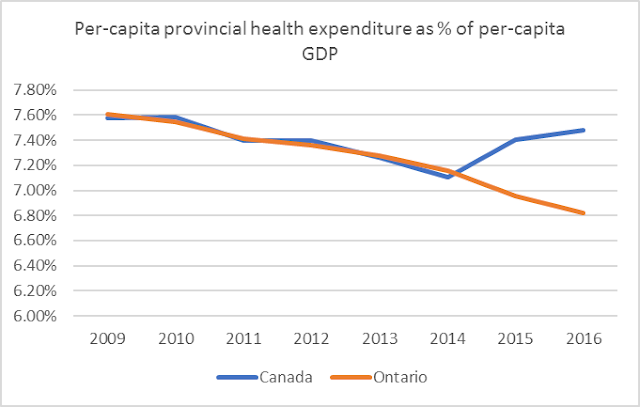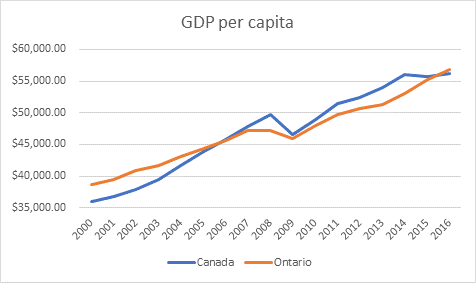Bowing to public pressure and the over-capacity crisis in our hospitals, the
Ontario minister of health and long-term care, Eric Hoskins, announced Friday hospital funding of $187 million to deal with next year’s flu
season.
While this is significant it is inadequate for several
reasons:
- The funding is for the next fiscal year. In other
words, the minister is merely leaking information that would normally be
released with the Budget.
- Most of this is not new money. Following pressure from
labour and the community, the minister announced $100 million for
hospitals last fall to fund 1,200 beds. But the government also made
clear that money may not continue in the next fiscal year starting April 2018 -- the continuation of the funding would depend on the "budgetary process". So this announcement merely confirms that this money will
continue at least one more year and, positively, that they will increase the annual
funding for this hospital bed program by $87 million.
- However, the $87 million increase represents less than half a
percent increase in overall hospital funding. By comparison, for this current year, the government claims it increased hospital funding $618 million. So this announcement is pretty small potatoes.
- Simply to offset existing cost pressures overall
funding will have to increase over ten times the $87 million announced Friday for next year. This announcement takes us no closer to confirming that will happen.
- The $100 million funding announced last fall was supposed to open 1,200 new hospital beds in the remaining 4 months of the fiscal year (December 2017 through March 2018 -- the flu season).
- The government suggests next year's $187 million will be used to make "more" beds available -- so presumably the $87 million in new money will be used, at least in part, to open more than the 1,200 beds funded for the current flu season. More beds is good -- if it happens. While last fall's announcement listed where most of the beds would be funded, this latest announcement came with no public report of where, or exactly how many, beds will be funded.
- The 1,200 beds are, in effect, funded at a lower level than acute care beds. Nevertheless to fund these beds for a full year would cost somewhere north of $300 million.
- So the limited $87 million funding increase to $187 million means there's little or no funding for beds for the period April 2018 through November 2018 (the eight months of the year outside of the flu season).
- As a result, the announcement is a bit like a confirmation that 1,200 beds will close -- or at least that there will be no provincial funding for the beds -- for the eight months outside the flu season.
- However, the shortage of hospital beds occurs both
during and after the flu season. We cannot afford to see the
closure of hospital beds for any part of the year. Unfortunately, this
funding announcement makes that much more likely.
- In sum, this announcement is a small funding increase that confirms there is little or no funding for the 1,200 beds outside the flu season (the period of "heightened demand"). Moreover, the funding announced falls well short of the funding increase required by hospitals. Much more must come through the provincial budget.
Are we breaking the old austerity funding pattern? While this small increase is significant it will not, by itself, reverse the trend toward spending a smaller and smaller portion of the economy on provincial health care funding -- even though increases in such spending are, in the long term, required.
In fact, provincial health care funding has been shrinking as a share of the economy for years. As of 2016, Ontario was in its 7th year in
a row where provincial expenditures on health care declined as a percentage of
the economy.
The Canadian Institute for Health Information forecasts
provincial health expenditures per-person will go up 1.9% in 2017 while the
economy will grow by 3.4% in nominal dollars per person -- i.e. almost twice as
much as health expenditures.
Unfortunately, $87 million in new money announced Friday
won't even come close to stopping that trend for 2018/19 - - much more will be
needed in the Budget.
In 1987, the Ontario government spent 5.18% of the total
economy on health – in 2016 it spent 6.82%.
This increase is natural, given the aging population and the tendency for
societies to spend proportionately more on health care as they become
richer. People want to live (oddly enough) and if there are more
resources -- and the bulk of the population has some control over those
resources (admittedly, far from certain these days) -- they will use those
resources to achieve that goal.
Ontario spends less than Canada as a whole: The
Ontario economy took a more serious hit than the rest of Canada during the
great recession of the last decade, pushing the share of the economy used by
the province to fund health care higher than Canada as a whole.
But, with strong growth in the last few years, Ontario is
now, once again, significantly below the rest of Canada in terms of the
percentage of the economy that the provincial governments spends on health
care. In 2016 Ontario spent 6.82% of the GDP while Canada as a whole spent
7.42%. That 0.6% gap will likely grow when the 2017 figures are in.
As shown below, almost all of this 0.6% gap (0.47% out of 0.60%) is due to the low level of provincial hospital funding in Ontario.
As shown below, almost all of this 0.6% gap (0.47% out of 0.60%) is due to the low level of provincial hospital funding in Ontario.
Ontario hospital expenditures are lower share of economy
than 25 years ago: Ontario provincial government hospital expenditure as
a share of the economy has declined -- not just since 2009, but since 1991.
Hospital funding is the
main factor in health funding's declining share of GDP: Hospital
funding accounts for most of the decline in overall provincial health
expenditure in Ontario since 2009, with hospital expenditure declining from
2.9% of GDP in 2009 to 2.44% in 2016. For the last thirty years, provincial hospital funding has been flat or declining as a percent of Gross Domestic Product.
This is true for both Ontario and Canada, but Ontario provincial government expenditure on hospitals has generally accounted for a lower proportion of the economy, with the gap growing sharply between Ontario and Canada since 2009.
In 2016 that gap had grown to 0.47% of the economy (2.91% provincial funding in Canada as a whole versus 2.44% in Ontario). If the Ontario government funded hospitals the same percentage of the economy as all provinces, there would be an extra $3.7 billion hospital funding annually.
Part of the decline of provincial health spending as a percentage of the economy in Ontario since 2009 is the significant growth in the economy.
As of 2016, Ontario has a higher GDP per-capita than
Canada. That is a return to the long term trend.
But significant economic growth in Ontario should also help Ontario turn away from the policies of austerity -- unless the forces of the right continue to seize that growth for the benefit of small parts of the population.





Comments
Post a Comment